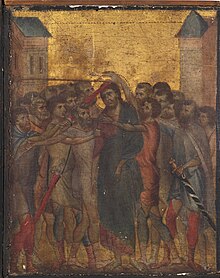The mocked Christ
The Mocked Christ is a painting by the Florentine painter Cimabue (c. 1240 - c. 1302).
The painting has a size of 25 cm × 20 cm and belongs to the altar polyptych "Passion and Crucifixion of Christ", which is dated to 1280. It is painted on a wooden panel and shows the passion scene of the "Mocking of Christ" with twenty figures in front of a gold-colored background.
During the dissolution of a ninety-year-old woman's household in Compiègne north of Paris in 2019 , an employee of the commissioned company noticed the small wooden panel painting, which she initially believed to be the work of an unknown Italian painter. The owner herself thought it was a Russian icon; it hung largely unnoticed in a hallway for decades and should actually be disposed of with the rest of the household effects. Only the art expert Eric Turquin, to whom the clerk brought the painting, recognized Cimabue's authorship. The painting was then sold at an auction in 2019 for 24 million euros. This makes it the most expensive painting before 1500 and the eighth most expensive by an old master .
Two other scenes from the same Passion of the Christ series by Cimabue are in the Frick Collection in New York and the National Gallery in London. This is indicated, among other things, by the location of the corridors of "woodworms" .
Individual evidence
- ↑ Kurt Kron: Cimabue painting almost landed on the trash , stuttgarter-zeitung.de, accessed on September 26, 2019
- ↑ AFP message. Source: Lippische Landes-Zeitung , volume 253, number 223/39 of September 25, 2019, p. 5.
- ↑ a b Stefan Trinks: Ox head on the stove - Was a cimabue discovered in a kitchen near Paris? , in: Frankfurter Allgemeine Zeitung for Germany, number 223/2019, September 25, 2019, p. 12.
- ↑ Cimabue painting: "The Mocked Christ" surprisingly turns women into multimillionaires . In: Spiegel Online . October 28, 2019 ( spiegel.de [accessed October 28, 2019]).
